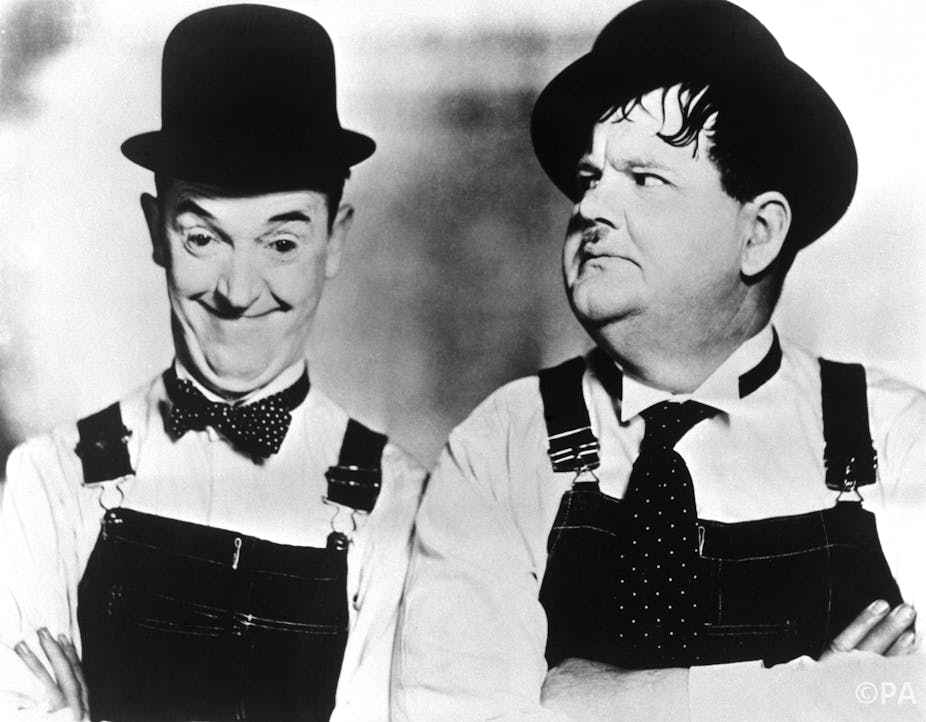Any show exploring the life of early film comedian Stan Laurel could be forgiven for focusing solely on Hollywood glitz and glamour. Across a film career that spanned some 34 years with his partner Oliver Hardy, Laurel won an Academy Award, successfully navigated the tricky transition from silent to talking film, performed for the Queen, and achieved a star on the Hollywood Walk of Fame. But the new one man show …And This is my Friend Mr Laurel – co-written by Gail Louw with actor Jeffrey Holland – gives audiences at the Edinburgh Fringe a look behind the scenes.
Born Arthur Stanley Jefferson in June 1890, Laurel moved to Glasgow as a young boy, working for his father at the Metropole Theatre. It was in Scotland that he made his break into music hall at the age of sixteen, by nabbing a slot in the Friday night amateur section at the popular Britannia Panopticon and winning over Glasgow’s notoriously difficult audiences. In Glasgow, Laurel nurtured a talent that was to soon take him to America. There, he teamed up with Fred Karno’s Barmy Army, and understudied for none other than Charlie Chaplin before he got his early break in film in 1917.
Some seven years later, Laurel found himself partnered with fellow comedian Oliver Hardy. As a pair, they went on to become one of the most famous comedy duos of all time. Together, they pedalled a mix of visual and verbal slapstick comedy that combined the child-like, effeminate innocence and clumsiness of Laurel with the heavy-set, harder, and more pompous Hardy character. Their skills in visual and physical comedy resulted in some of the great comic films of the early sound era, including The Battle of the Century (1927), notorious for its anarchic and ridiculously lengthy pie-fighting climax.
Yet their off-screen personas were in many respects the reversal of their on-screen characters. Laurel was was not just a performer - he was the driving creative and technical force behind their routines and their films. Like his comedic contemporaries Charlie Chaplin and Buster Keaton, Laurel also wrote and directed, honing his technical skills behind the camera for some ten years before partnering with Hardy.
Fuelled by his dedication to producing the best results for his audience, Laurel would attend previews, adjusting the length of individual shots or sequences in response to crowd reactions, maximising the laughter. Laurel’s appeal to cinema fans was obvious from the outset. Numerous early trade papers report the great enthusiasm of their audiences for Laurel and Hardy pictures, while fan correspondence shows a huge range of letters, artworks and illustrations dedicated to the pair across their careers.
Laurel cultivated this relationship with an unusual level of devotion to his audiences. He was a hugely prolific letter writer. He spent much of his retirement after Hardy’s death in the mid-1950s answering fan mail personally. He kept his home telephone number publicly listed, and went so far as to invite individual fans to visit him at his home. Speaking in 1957, Laurel remarked that in writing back to fans, he “included their name and everything, and I think that they brought a closeness for people. They felt that they were our friend, we were their friend.”
The lasting appeal of Laurel and Hardy is as much about their off-screen friendship as their onscreen chemistry. This sense of them as “friends” of their audiences, able to provide laughter and chaos with the sense that Stan and Ollie’s own friendship would outlast every misadventure, would seem to account for their continued ability to find new audiences.
Television was responsible for generating a whole new fan base for the pair, when their back catalogue of comedies was broadcast for the small screen in the 1950s. Into the digital era, platforms like YouTube offer a seemingly ideal home for the Laurel and Hardy short, bringing new viewers to their material and generating hundreds of thousands of hits as their gags are ripped, shared and redistributed. Hardy’s infamous fourth-wall breaking, direct to camera glances are now meeting 21st century eyes.
If Laurel still matters today, it is as much for his technical contribution to the history of early film comedy as for the diverse meanings he continues to carry for cinemagoers all over the world. Laurel and Hardy are woven into the fabric of contemporary global popular culture. Their likenesses are used in commercials and on album covers. They can be found immortalised in all manner of weird and wonderful cinema ephemera; from ceramic busts to kitchen trays to their own Laurel and Hardy magazine series.
But they are also woven into distinctly local histories, offering a tangible connection between old time Hollywood glamour and the legacies of regional media. In Laurel’s home town of Ulverston, for example, a statue of the duo erected in 2009 leans up against a lamp-post in the town centre; over on Brodgen Street stands the Laurel and Hardy museum. Venture a little further into the town and you will find the Stan Laurel Inn, named after “Ulverston’s most famous son.”
Holland’s show presents another opportunity for the marrying of the global icon to regional heritage. Laurel’s father, Arthur J Jefferson, had originally hoped his son would take over management of the Metropole – a career path that would have kept him rooted in Glasgow, behind the scenes, and away from the cameras. But Laurel’s ambition exceeded the confines of this one theatre. Even so, it is fitting, perhaps, that Stan Laurel should return to Scotland - the birthplace of his own particular brand of comedic genius, where he fostered a talent that would eventually lead him to Hollywood, to Hardy, and to a permanent place in film history.

